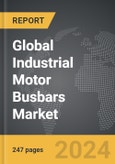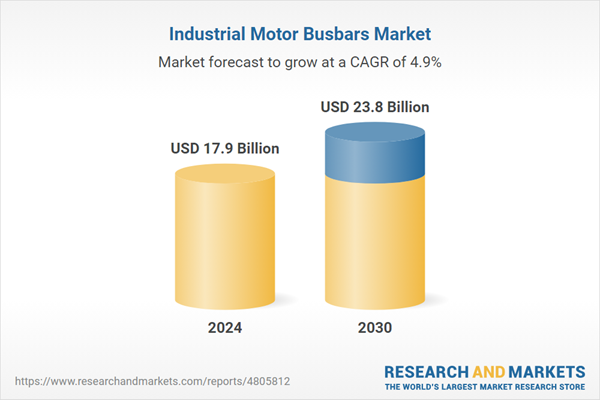Global Industrial Motor Busbars Market - Key Trends & Drivers Summarized
Why Are Industrial Motor Busbars Essential for Modern Power Distribution?
Industrial motor busbars play a crucial role in power distribution systems, ensuring efficient and reliable transmission of electricity in industrial environments. Unlike conventional cabling systems, busbars provide a compact, scalable, and cost-effective alternative for high-power applications, making them indispensable in industries such as manufacturing, automotive, aerospace, and energy. These rigid yet modular conductors facilitate the distribution of electrical power to motors, transformers, and heavy-duty machinery while minimizing energy losses and improving overall system efficiency. The demand for busbars has grown significantly with the increasing complexity of industrial automation and the need for uninterrupted power supply in critical operations. The shift toward high-density manufacturing plants and large-scale industrial facilities has further accelerated the adoption of busbar trunking systems, as they offer superior heat dissipation, lower electrical resistance, and higher current-carrying capacity compared to traditional wiring methods. Additionally, industrial motor busbars ensure enhanced safety and ease of maintenance, as their enclosed design reduces the risk of electrical faults, short circuits, and fire hazards. The growing focus on energy efficiency and sustainable power solutions has also led to innovations in busbar materials, including the use of copper and aluminum alloys that enhance conductivity while minimizing environmental impact.How Are Technological Innovations Transforming Industrial Motor Busbars?
Technological advancements in electrical engineering and power distribution have significantly improved the performance and application scope of industrial motor busbars. The integration of smart monitoring systems, IoT-enabled sensors, and real-time diagnostics has enhanced the efficiency, reliability, and predictive maintenance capabilities of busbar systems. Modern busbars are now equipped with thermal imaging sensors, voltage monitoring devices, and AI-driven analytics that help identify potential faults before they escalate into major failures, thereby reducing downtime and operational risks. Furthermore, advancements in insulation technology have led to the development of epoxy-coated and sandwich-type busbars, which offer superior protection against environmental factors such as moisture, dust, and chemical exposure. The increasing emphasis on modular and flexible power distribution solutions has also led to the design of plug-and-play busbar systems, allowing industries to scale their electrical infrastructure effortlessly in response to evolving power demands. Moreover, the rise of renewable energy integration has necessitated the use of advanced busbar configurations that support the efficient transmission of power from solar farms, wind turbines, and battery storage systems to industrial machinery. As industries continue to move toward Industry 4.0, the adoption of smart busbar systems that seamlessly integrate with automated production lines and robotic systems is expected to gain further momentum, driving innovations in material science, heat dissipation techniques, and compact design configurations.Why Is the Demand for Industrial Motor Busbars Surging Across Key Sectors?
The growing adoption of industrial motor busbars is largely driven by the rising need for efficient, scalable, and low-maintenance power distribution solutions across multiple industries. In the manufacturing sector, the increasing reliance on high-power machinery, automated production lines, and robotics has intensified the demand for busbars that can handle high voltage loads while maintaining operational efficiency. The automotive industry, particularly the electric vehicle (EV) manufacturing segment, has emerged as a key consumer of busbar systems, as they play a vital role in high-voltage battery packs, power electronics, and electric drivetrains. The expansion of data centers and IT infrastructure has also contributed to the rising use of busbars, given their ability to support high-density power distribution while reducing space constraints and heat generation. The energy sector, particularly in renewable energy applications, is another major driver of busbar adoption, as these systems are essential for integrating solar and wind power into industrial grids with minimal transmission losses. Additionally, industries such as oil and gas, mining, and chemical processing are increasingly shifting toward busbar solutions due to their ability to withstand harsh operating conditions, including extreme temperatures, corrosive environments, and heavy mechanical loads. With urbanization and infrastructure development on the rise, the demand for industrial motor busbars in commercial buildings, metro rail systems, and large-scale industrial complexes is also experiencing significant growth, further reinforcing their role as a critical component in modern electrical power networks.What Are the Key Factors Driving the Growth of the Industrial Motor Busbars Market?
The growth in the industrial motor busbars market is driven by several factors, including advancements in power distribution technology, the increasing adoption of electric vehicles, and the rising demand for energy-efficient solutions in industrial settings. The shift toward automation and smart factories has accelerated the need for intelligent busbar systems that enable real-time power monitoring, fault detection, and predictive maintenance, reducing downtime and enhancing operational efficiency. The rapid expansion of renewable energy projects, particularly solar and wind farms, has also fueled the demand for high-performance busbars capable of efficiently transmitting power from generation sources to industrial equipment. Additionally, the growing electrification of industries and the push for sustainable energy consumption have led to the increased use of aluminum busbars, which offer cost-effective and lightweight alternatives to traditional copper-based systems. The surge in electric vehicle production and charging infrastructure development is another critical factor boosting market growth, as busbars play an integral role in high-voltage battery management and fast-charging networks. Furthermore, regulatory mandates emphasizing energy conservation and carbon footprint reduction have prompted industries to adopt busbar trunking systems that minimize electrical losses and improve overall power efficiency. The continued rise of data centers and cloud computing facilities has also contributed to the market expansion, as busbars provide the high-density power distribution needed to support mission-critical IT operations. As industrial operations become more complex and energy-intensive, the demand for advanced, modular, and scalable busbar solutions is expected to increase, shaping the future of power distribution across diverse sectors.Report Scope
The report analyzes the Industrial Motor Busbars market, presented in terms of units. The analysis covers the key segments and geographic regions outlined below.Segments: Conductor (Copper, Aluminum); End-Use (Utilities, Residential, Commercial, Industrial).
Geographic Regions/Countries: World; United States; Canada; Japan; China; Europe (France; Germany; Italy; United Kingdom; Spain; Russia; and Rest of Europe); Asia-Pacific (Australia; India; South Korea; and Rest of Asia-Pacific); Latin America (Argentina; Brazil; Mexico; and Rest of Latin America); Middle East (Iran; Israel; Saudi Arabia; United Arab Emirates; and Rest of Middle East); and Africa.
Key Insights:
- Market Growth: Understand the significant growth trajectory of the Copper Conductor segment, which is expected to reach US$14.6 Billion by 2030 with a CAGR of a 4.7%. The Aluminum Conductor segment is also set to grow at 5.2% CAGR over the analysis period.
- Regional Analysis: Gain insights into the U.S. market, valued at $4.8 Billion in 2024, and China, forecasted to grow at an impressive 8.1% CAGR to reach $5.1 Billion by 2030. Discover growth trends in other key regions, including Japan, Canada, Germany, and the Asia-Pacific.
Why You Should Buy This Report:
- Detailed Market Analysis: Access a thorough analysis of the Global Industrial Motor Busbars Market, covering all major geographic regions and market segments.
- Competitive Insights: Get an overview of the competitive landscape, including the market presence of major players across different geographies.
- Future Trends and Drivers: Understand the key trends and drivers shaping the future of the Global Industrial Motor Busbars Market.
- Actionable Insights: Benefit from actionable insights that can help you identify new revenue opportunities and make strategic business decisions.
Key Questions Answered:
- How is the Global Industrial Motor Busbars Market expected to evolve by 2030?
- What are the main drivers and restraints affecting the market?
- Which market segments will grow the most over the forecast period?
- How will market shares for different regions and segments change by 2030?
- Who are the leading players in the market, and what are their prospects?
Report Features:
- Comprehensive Market Data: Independent analysis of annual sales and market forecasts in US$ Million from 2024 to 2030.
- In-Depth Regional Analysis: Detailed insights into key markets, including the U.S., China, Japan, Canada, Europe, Asia-Pacific, Latin America, Middle East, and Africa.
- Company Profiles: Coverage of players such as ABB Group, Eaton Corporation PLC, General Electric Company, Legrand Group, Schneider Electric SA and more.
- Complimentary Updates: Receive free report updates for one year to keep you informed of the latest market developments.
Some of the 48 companies featured in this Industrial Motor Busbars market report include:
- ABB Group
- Eaton Corporation PLC
- General Electric Company
- Legrand Group
- Schneider Electric SA
- Siemens AG
Tariff Impact Analysis: Key Insights for 2025
Global tariff negotiations across 180+ countries are reshaping supply chains, costs, and competitiveness. This report reflects the latest developments as of April 2025 and incorporates forward-looking insights into the market outlook.The analysts continuously track trade developments worldwide, drawing insights from leading global economists and over 200 industry and policy institutions, including think tanks, trade organizations, and national economic advisory bodies. This intelligence is integrated into forecasting models to provide timely, data-driven analysis of emerging risks and opportunities.
What’s Included in This Edition:
- Tariff-adjusted market forecasts by region and segment
- Analysis of cost and supply chain implications by sourcing and trade exposure
- Strategic insights into geographic shifts
Buyers receive a free July 2025 update with:
- Finalized tariff impacts and new trade agreement effects
- Updated projections reflecting global sourcing and cost shifts
- Expanded country-specific coverage across the industry
Table of Contents
Companies Mentioned (Partial List)
A selection of companies mentioned in this report includes, but is not limited to:
- Abb Group
- Eaton Corporation Plc
- General Electric Company
- Legrand Group
- Schneider Electric Sa
- Siemens Ag
Table Information
| Report Attribute | Details |
|---|---|
| No. of Pages | 247 |
| Published | April 2025 |
| Forecast Period | 2024 - 2030 |
| Estimated Market Value ( USD | $ 17.9 Billion |
| Forecasted Market Value ( USD | $ 23.8 Billion |
| Compound Annual Growth Rate | 4.9% |
| Regions Covered | Global |









